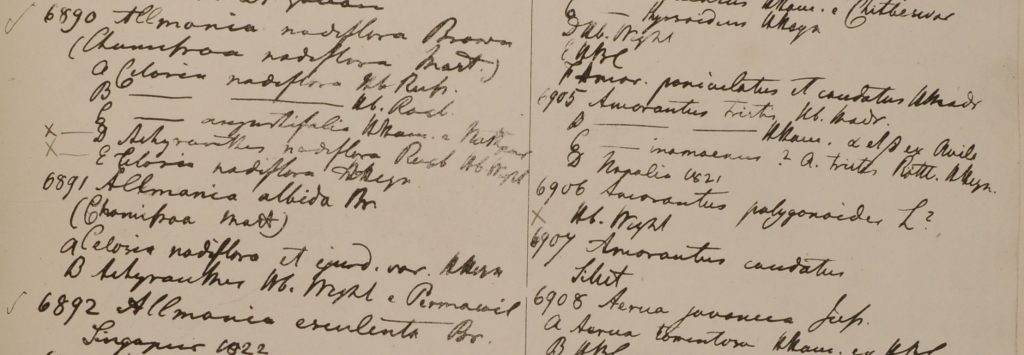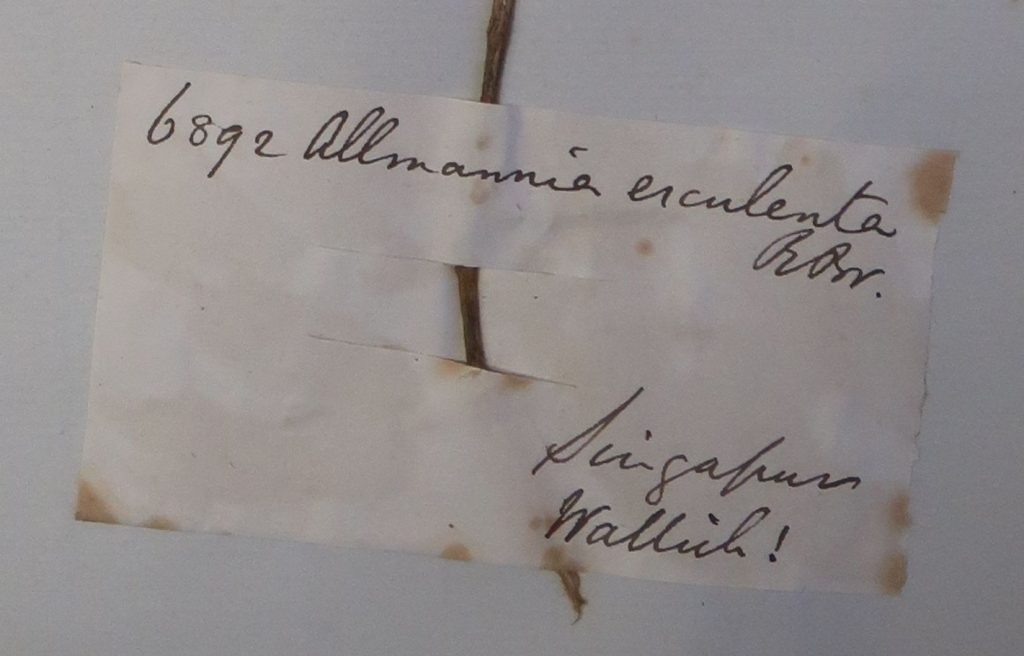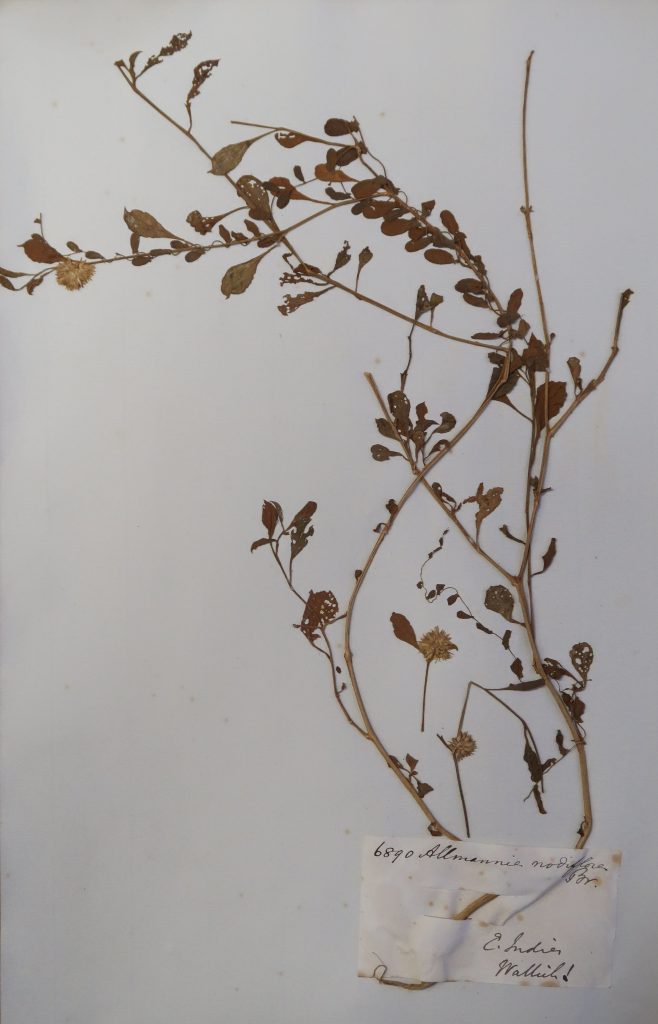The official establishment of the Herbarium at Trinity College Dublin is taken as 1840, with the appointment of Thomas Coulter (1793–1843) as the first Keeper and the incorporation of his personal herbarium collection of 20,000 species.1 However, the ‘germ of a collection of plants’ was set in the eighteenth century, when Sir Hans Sloane (1660–1753) presented the Museum of Trinity College with a ‘thick folio’ of dried specimens – a Hortus Siccus.2 Although Irish naturalist Robert Ball (1802–1857), Director of the Museum from 1844, recognised that this contained a considerable number of plants, he considered them ‘of no value … except as a relic’, as most were specimens of cultivated plants growing in Sloane’s garden. Sloane’s volume rubbed shoulders with other historically important material, including three small bundles of specimens which Ball thought ‘in tolerable preservation,’ collected during the voyages of Captain James Cook (1728–1779) on the island of ‘Tanna’ (in the New Hebrides), New Caledonia and New Zealand. These were presumably made by Johann Reinhold Forster (1729–1798) and his son Georg (1754–1794), naturalists on Cook’s second voyage (1772–5), and given to Trinity College by the Royal Society through connections with Sir Joseph Banks (1743–1820) – naturalist on Cook’s first voyage, 1768–71, and later President of the Royal Society. Besides ‘a few other plants’ in the Museum, Ball gave special mention to ‘a set of Wallich’s plants presented by the Hon. East India Company, together with a copy of the “Catalogue”.’

The great Wallichian distribution of the Hon. East India Company Herbarium was undertaken by Nathaniel Wallich (1786–1854) from Soho, London, between 1828 and 1832, with the residue distributed in the two years after his return to England in 1847. Comprising of over 20,000 collections representing some 8,500 different species, many named scientifically for the first time, this was arguably the most extensive and important distribution of plant specimens ever made. It is particularly valued as the basis of botanical documentation in many parts of south and southeast Asia, especially Bangladesh, India, Malaysia, Myanmar, Nepal, and Singapore. Wallich and his local collectors made the bulk of the collections, but plant material was also sent to Wallich at the Calcutta Botanic Garden by East India Company employees from all corners of the Company’s territories. Boxes of Indian specimens collected by Scottish naturalists Francis Buchanan-Hamilton (1762–1829), George Finlayson (1790–1823), William Roxburgh (1751–1815), Patrick Russell (1726–1805), and Robert Wight (1796–1872), as well as a group of German naturalists based in Madras, were also given to Wallich from the storerooms of the EIC’s India Museum in London, to incorporate into his distribution . Most of these collections had many duplicates, with over 60 individuals and institutions benefitting from sets of specimens in various levels of completeness.

With such a vast volume of material to distribute, Wallich adopted a novel approach to producing the 1.2 million specimen labels required. He used a rather crude version of transfer lithography to print copies of his handwritten list on thin sheets of paper, with scientific names and collection data in two columns. These loose-leaf pages were sent with the bundles of specimens and intended to be cut up as labels. However, recipients often chose to keep their pages intact as a catalogue. Such individuals ticked off the specimens they received and either transcribed the collection information onto their herbarium sheets, or relied on the catalogue number alone as a cross-reference. Boundcopies of what became known as the Wallich Catalogue have either 268 pages, if they only relate to the distribution of the first 7683 species, or the full 306 pages if the recipient also received specimens from the final dispersal.4

In 1846 Ball noted, rather snidely, that the set Wallich sent to Trinity College Museum was ‘a very imperfect one, including only about 700 species out of the 7000 which are enumerated in the Catalogue.’ The Museum was not included in Wallich’s initial list of recipients in June 1831, but was added in his March 1832 update, and by September he recorded that five parcels and five palm sections had been sent to Dublin. This places Trinity College in the middle of those who received specimens if ranked by parcel number: higher than King’s College London and London University. It was through the Irish Professorof Botany at Trinity College, William Allman (1776–1846)5, and his connections with Robert Brown (1773–1858) in London – Keeper of Botany at the British Museum – that Trinity College Museum was added to the Wallichian Distribution.6 Having named a new genus of Amaranthaceae after his friend, Brown was no doubt keen for Allman to receive material of these, and other specimens from the East India Company Herbarium. Specimens of Wall. Cat. 6890 Allmania nodiflora, 6891 Allmania albida, and 6892 Allmania esculenta can still be found in the Trinity College Herbarium (TCD7), mounted on laid paper watermarked 1843, with the temporary slips of paperwritten in Wallich’s hand (these were never replaced by labels made from the printed list). A few of Wallich specimens were later sent from Trinity College to the National Museum and are now in the herbarium at National Botanic Gardens, Glasnevin (DBN). Sadly, the copy of the Wallich Catalogue is nowhere to be found in the Trinity College, Department of Botany or Glasnevin, and cannot be traced in catalogues and indices in the main library of the university or the National Library of Ireland.

The listing of the generic name Allmania was not sufficient for valid publication as no description was provided in the Wallich Catalogue. It fell to Robert Wight to validate the genus in 1834 in Hooker’s Journal of Botany, making the new combination Allmania nodiflora (L.) R.Br. ex Wight, based on Celosia nodiflora. Allmania albida (Willd.) R.Br. ex Hook.f. (based on Celosia albida) was not validly published until much later, in Joseph Hooker’s Flora of British India (1885), and Allmania esculenta was never taken up by later authors. Today the genus Allmania is considered to include only a single species, its type Allmania nodiflora.
The main Wallich Catalogue project homepage gives background information on the Wallich Catalogue, and links to further explainatory pages as they are written.
Acknowledgements
I am indebted to Matthew Jebb, Martin Krieger, Charles Nelson, Henry Noltie, John Parnell and Peter Wyse Jackson for their help in preparing this article.
Notes
1 Webb, David A. (1991). The herbarium of Trinity College, Dublin: its history and contents. BotanicalJournal of the Linnean Society, 106: 295–327. Coulter brought with him his personalherbarium of 20,000 specimens.
2 Ball, Robert (1846). The Dublin University Museum, January 1846. Dublin. pp 1–11.
3 Wright, Ed. Perceval (1896). The herbarium of Trinity College: a retrospective. Notes from the Botanical School of Trinity College, Dublin, 1: 1–14.
4 The Wallich Catalogue (also Wallich’s Catalogue, Wallichian Catalogue, Wallich’s List or Numerical List), 1828-32, 1849-51. The title on the first leaf of the lithographed series is ‘A numerical list of dried specimens of plants in the East India Company’s Museum, collected under the superintendence of Dr. Wallich of the Company’s Botanic Garden at Calcutta.’ A digitised and fully transcribed, interactive version of the Wallich Catalogue is available online (http://wallich.rbge.info).
5 William Allman, son of Thomas Allman, was born in Kingston, Jamaica on 7 February 1776, but moved to Ireland at the age of four years in 1780. He was educated in Waterford, his mother’s native town, and at Trinity College Dublin where he obtained a scholarship, and graduated B.A. in 1796, M.A. in 1801, and M.D. in 1804. He practised medicine in Clonmel, County Tipperary until his appointment as Professor of Botany at Trinity in 1809. As afriend of Robert Brown it is probably not surprising that he arranged his lectures in 1812 on the Natural System, but was the first botanical lecturer in Britain or Ireland to do so. Allman retired in 1844 and was succeeded in his chair by the unrelated George James Allman, who later became Regius Professor of Natural History at Edinburgh. William’s son, George Johnston Allman (confusingly with the same initials as his father’s successor), was also anacademic, and became Professor of Mathematics at Queen’s University, Belfast.
6 The formal offer of a set of specimens by the Directors of the East India Company was made early in 1832, as on 14 February Wallich received the following acceptance letter from Allman:
Dr Allman presents his Compliments to Dr Wallich, feels much obliged by the Honour of his Communications, and by the liberal Offer of the Chairman and Deputy Chairman of the East India Company to the Museum of Trinity College. It is thankfully accepted, and Authority shortly to be given to a trusty Person (it is supposed of the Thames Steamer) to receive the articles, for the purpose of safely conveying them to Dublin. Dr A. requests the offer of his best respects to Mr R. Brown, when after some time he may probably have occasion to trouble with a Communication.
4 Marino Crescent, [Clontarf,] Dublin, 11 Feby 1832.
Dr Wallich &c, &c, 61 Frith St, Soho, London
[Wallich Correspondence Vol. 7, Central National Herbarium, (CAL), Acharya Jagadish Chandra Bose Indian Botanic Garden]
7 Acronyms of herbaria, traditionally printed in bold, follow the international standard given in Index Herbariorum (Thiers, Barbara [continuously updated]. Index Herbariorum: A global directory of public herbaria and associated staff. New York Botanical Garden’s Virtual Herbarium. http://sweetgum.nybg.org/science/ih/).
